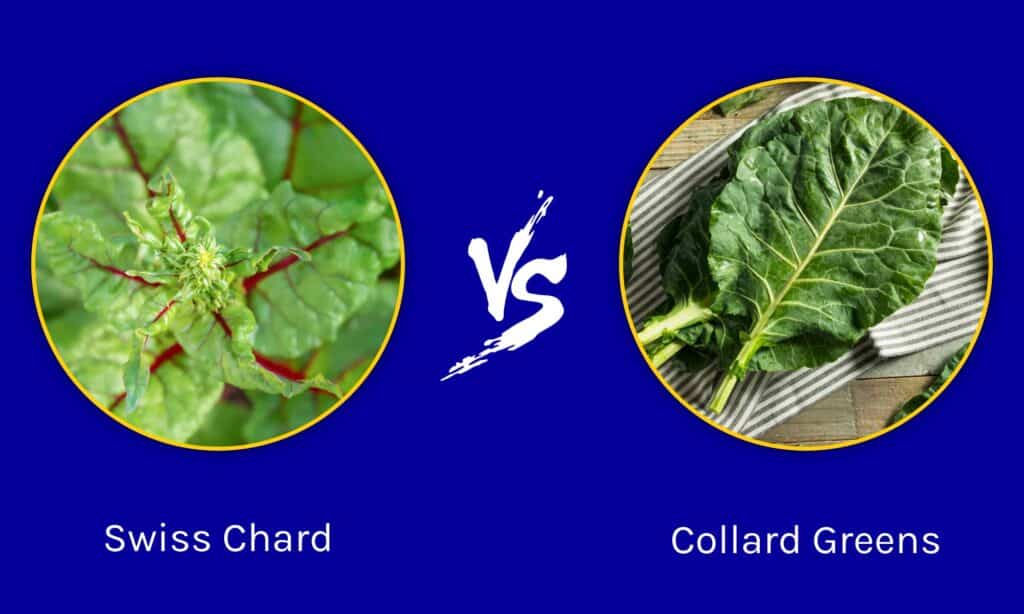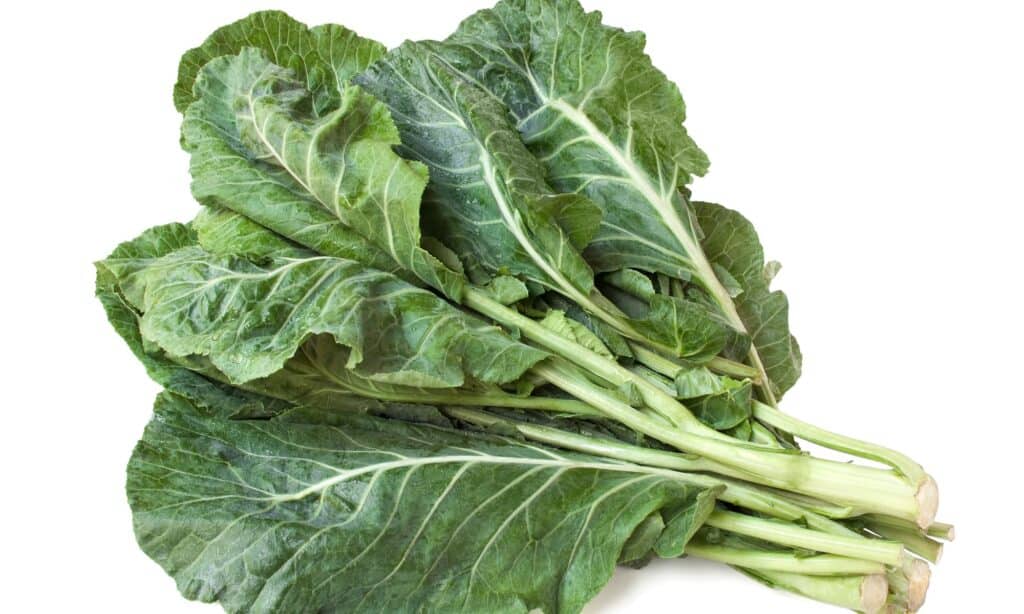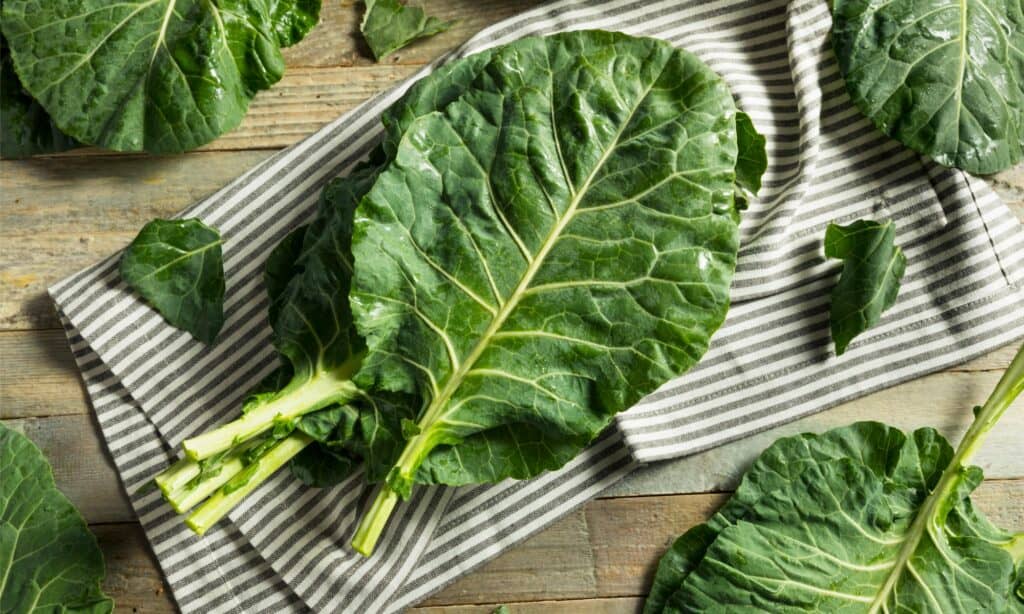Swiss chard and collard greens are plants widely used in salads, soups, or as a side dish for fish or meat. Besides having a pleasant taste, they are rich in vitamins and minerals.
If you’ve landed on this page, you’re probably planning to sow and grow one of these plants or wondering which one you should include in your diet.
How are they grown and harvested? How do they look and taste? And more importantly, how are they used daily? Keep on reading to find all the answers!
Comparing Swiss Chard vs. Collard Greens

| Swiss Chard | Collard Greens | |
|---|---|---|
| Classification | Species: Beta vulgaris Cultivar group: Flavescens Group | Species: Brassica oleracea Cultivar group: Acephala Group |
| Growth and harvesting | Best sown from April to August at a 0.59-inch depth; rows need to be 16-18 inches apart; grows slower during summer; harvested when the plants are 6-8 inches tall; requires regular harvesting so that the plant produces continually. | Often planted in late spring, late summer, and early fall, no deeper than 0.5-1 inch; rows need to be 36-42 inches apart if leaves will be periodically cut; requires regular harvesting so that the plant produces continually. |
| Description and taste | Broad, shiny, green leaves; white to yellow to red petioles (stalks that attach leaf blades to the stems); The leaves taste sweet, earthy, and a bit bitter; the stalks have a sweet celery-like taste. | Large, green leaves that are thick and bitter; tough, fibrous stems that are edible but not preferred in recipes. |
| Uses | Most often served raw in salads, soups, omelets, tortillas, and stir-fries; can be boiled or sauteed; has edible stalks. | Most often served cooked; sauteed, stewed with meat or vegetables, boiled, side dish for fish or meat. |
| Origin | Sicily | Greece |
| Nutritional values per 3.5 oz (100 g) | – Energy: 84 kJ (20 kcal) – Carbohydrates: 0.14 oz (4.13 g) – Fat: 0.003 oz (0.08 g) – Protein: 0.07 oz (1.88 g) – Vitamins: A, B1, B2, B3, B5, B6, B9, C, E, K – Minerals: calcium, iron, magnesium, manganese, phosphorus, potassium, sodium, zinc – Water: 3.27 oz (92.65 g) | – Energy: 137 kJ (33 kcal) – Carbohydrates: 0.2 oz (5.6 g)Fat: 0.03 oz (0.7 g) – Protein: 0.09 oz (2.7 g) – Vitamins: A, B1, B2, B3, B5, B6, B9, C, E, K – Minerals: calcium, iron, magnesium, manganese, phosphorus, potassium, sodium, zinc – Water: 3.19 oz (90.2 g) |
| Recommended varieties to plant | Burpee’s Rhubarb Chard, Verde da Taglio, Fordhook Giant | Green Glaze, Flash Vates, Blue Max |
The Key Differences Between Swiss Chard and Collard Greens
While these two plants may look similar, they have different origins, are classified differently, and have dissimilarities in terms of appearance. Swiss chard leaves and collard greens do not taste the same and also feature different nutritional values! Check out these key differences between Swiss chard leaves and collard greens to learn more about the two!
Swiss Chard vs. Collard Greens: Classification

Collard greens are part of the
Brassica oleraceaspecies.
©iStock.com/EvergreenPlanet
The Swiss chard vegetable belongs to the Amaranthaceae family. It was first called Beta vulgaris var. cicla in 1753. Since then, its scientific classification has undergone many changes. Nowadays, all beet cultivars, including chard and beetroot, are called Beta vulgaris subsp. vulgaris, and they descend from the sea beet, scientifically called Beta vulgaris subsp. maritima. Chards feature two cultivar groups: leafy spinach beet, which belongs to the Cicla Group, and stalky Swiss chard, which belongs to the Flavescens Group.
Collard greens are part of the Brassica oleracea species, which includes many other plant species, such as cabbage, cauliflower, broccoli, and kale. There are some debates in terms of what group this plant belongs to. Some sources list it as a member of the Viridis group, while older sources list it as belonging to the Acephala group.
Swiss Chard vs. Collard Greens: Etymology
Contrary to what we’d think at first glance, the “Swiss chard” name does not indicate that the vegetable originates from Switzerland.
“Chard” comes from the Latin word carduus, which means artichoke thistle. The “Swiss” part has been the topic of many debates, as its origin is unclear, and it definitely doesn’t indicate the vegetable’s origin because it’s native to Sicily. Some scientists believe that the Swiss part comes from one of the first botanists who described this plant, Gaspard Bauhin, who was from Switzerland.
The “collard” etymology is much easier. The term comes from a medieval word used to describe non-heading brassica crops. This word was “colewort,” which later became “collard.”
Swiss Chard vs. Collard Greens: Description

Collard stalks are more fibrous than Swiss chard stalks.
©iStock.com/bhofack2
You can easily tell Swiss chard leaves apart from collard greens by their distinctive colors. Swiss chard leaves are large and dark green, while the stalks are crisp. The stalks feature unique colors, ranging from white to yellow to red.
Although collards have large green leaves, their stalks aren’t brightly colored. While Swiss chard stalks can be eaten, collard stalks are more fibrous, and most people prefer removing them before cooking.
Swiss chard leaves and collard greens taste similar – they’re both slightly bitter. Collard greens aren’t as bitter as kale, while the bitter taste of Swiss chard leaves is mixed with a sweet taste.
Swiss Chard vs. Collard Greens: Growth and Harvesting
While both Swiss chard and collard are typically grown as cool-season plants, their growth and harvesting processes are slightly different.
It’s best to plant Swiss chard as early as March and until August or September. It needs to be sown approximately 0.59 inches deep. Then, it needs to be covered with soil and watered. Swiss chard rows have to be placed about 16-18 inches apart.
Harvesting is possible when the plants are 6-8 inches tall. We advise cutting the outer leaves first – they are the youngest and taste the best! Then, cut off individual leaves until you reach the center, but don’t wait until they’re fully grown. Ensure to leave a small stump after cutting the leaves. This method will allow the plant to continue growing and producing leaves. Regular harvesting will facilitate continuous growing.
Collard is a cool season plant. If you live in the southern regions, it’s best to sow it in late summer or early autumn. If you live in northern regions, you can sow it earlier – in late spring or early summer. This vegetable can survive frost and may taste better if it grows at low temperatures.
The seeds need to be placed no deeper than 0.5 – 1 inch in moist soil. Collard rows should be at least 36-42 inches apart because the leaves get pretty large.
Just like it’s done with the Swiss chard vegetable, you should cut the outer collard leaves first and then cut the rest one by one until you reach the center. Some gardeners recommend cutting the leaves before they reach 10 inches long and become dark green. At this point, they’re still young and tasty. If they grow older, they’ll become tougher.
If you want to learn more about Swiss chard or collard green varieties, check out this website!
Swiss Chard vs. Collard Greens: Nutritional Value and Uses

Swiss chard leaves are rich in minerals, mainly iron, magnesium, manganese, potassium, and zinc.
©iStock.com/Petra Richli
Both vegetables have significant nutritional value, as they are extremely rich in vitamins and minerals. That’s why they should be periodically included in everyone’s diet.
Collard greens are richer in carbohydrates, proteins, and vitamins, especially vitamin K. Swiss chard leaves have low carbohydrate, protein, and fat content and are richer in minerals, mainly iron, magnesium, manganese, potassium, and zinc. You should choose between the two depending on what your diet lacks – carbohydrates and vitamins or minerals.
Both plants are widely used in various dishes. Swiss chard is often used uncooked in salads, soups, or omelets. It can also be boiled or sauteed. If cooked, it won’t be that bitter.
While collard greens are sometimes eaten raw, people often serve them cooked as a side dish for fish, meat, or in soups. They can be boiled, sauteed, or stewed with meat or vegetables.
Up Next:
- Collard Greens vs. Kale: What’s the Difference?
- Turnip Greens vs. Collard Greens: What’s the Difference?
- Mustard Greens vs. Collard Greens: What’s the Difference?
The photo featured at the top of this post is © iStock.com/bhofack2
Sources
- NC State Extension, Available here: https://content.ces.ncsu.edu/collard-greens
- RHS, Available here: https://www.rhs.org.uk/vegetables/chard/grow-your-own
- Gardeners World, Available here: https://www.gardenersworld.com/how-to/grow-plants/how-to-grow-swiss-chard-2/
Thank you for reading! Have some feedback for us? Contact the AZ Animals editorial team.







